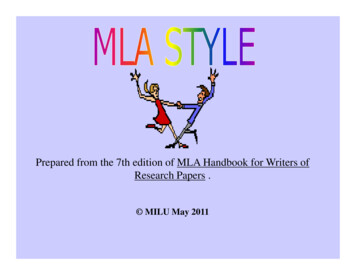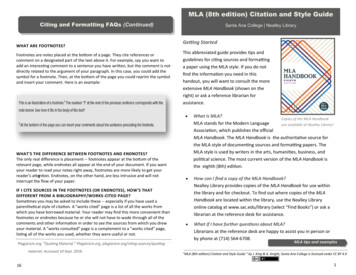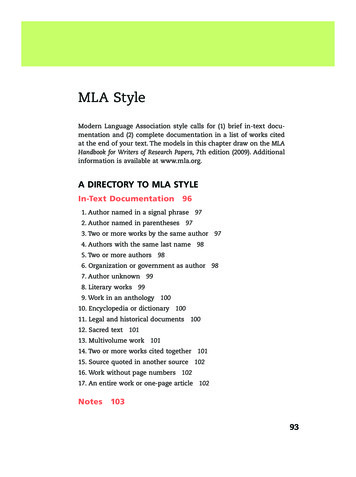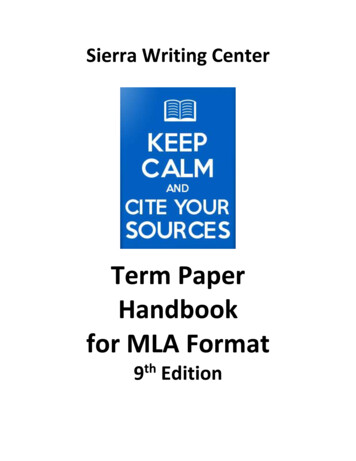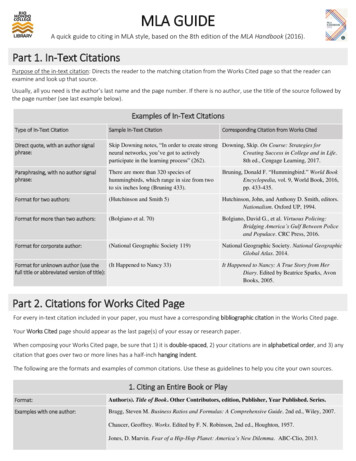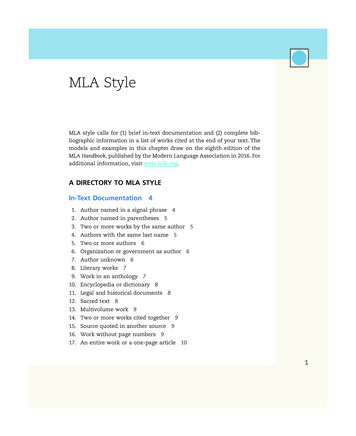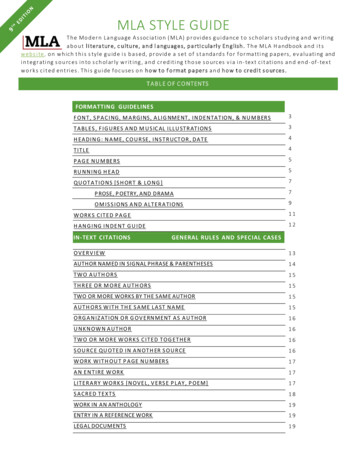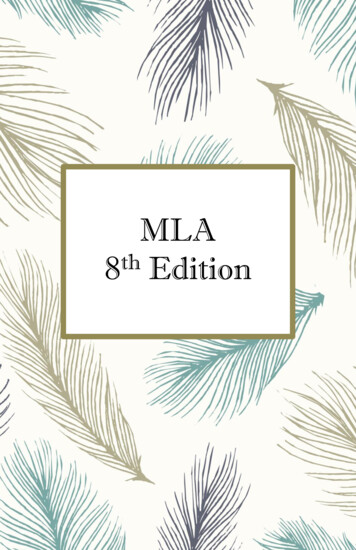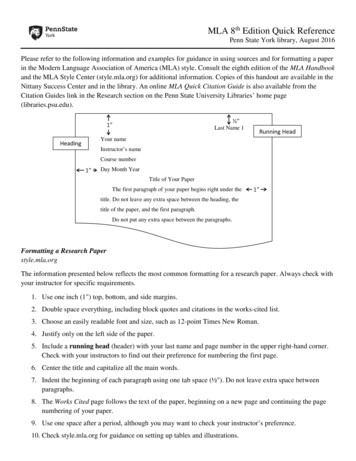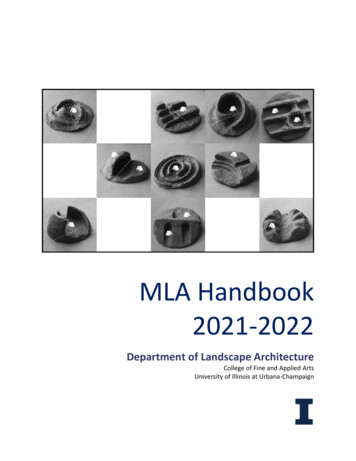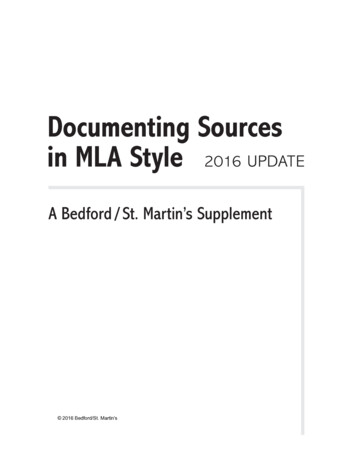
Transcription
FRONTDocumenting Sourcesin MLA Style 2016 UpDATeA Bedford / St. Martin’s Supplement 2016 Bedford/St. Martin's01 HAC 08268 FM i vi.indd 118/05/16 11:00 AM
2016 Bedford/St. Martin's01 HAC 08268 FM i vi.indd 218/05/16 11:00 AM
DocumentingSources inMLA Style:2016 UpdateA Bedford/St. Martin’sSupplementBoston New York 2016 Bedford/St. Martin's01 HAC 08268 FM i vi.indd 118/05/16 11:00 AM
Copyright 2016 Bedford/St. Martin’sAll rights reserved. No part of this book may be reproduced, stored in aretrieval system, or transmitted in any form or by any means, electronic,mechanical, photocopying, recording, or otherwise, except as may beexpressly permitted by the applicable copyright statutes or in writing bythe Publisher.Manufactured in the United States of America.1f0e9d8c7b6aFor information, write: Bedford/St. Martin’s, 75 Arlington Street, Boston, MA02116 (617-399-4000)ISBN 978-1-319-08268-0 2016 Bedford/St. Martin's01 HAC 08268 FM i vi.indd 218/05/16 11:00 AM
ContentsElements of MLA citations 1MLA in-text citations 3Directory to MLA in-text citation models MLA list of works cited General guidelines for listing authors Directory to MLA works-cited models General guidelines for the works-cited list Articles and other short works Books and other long works Online sources Visual, audio, multimedia, and live sources Other sources 49910121517202225MLA-style formatting 27Sample pages from student writing in MLA style 29Sample MLA research project 36 2016 Bedford/St. Martin's01 HAC 08268 FM i vi.indd 3iii18/05/16 11:00 AM
2016 Bedford/St. Martin's01 HAC 08268 FM i vi.indd 418/05/16 11:00 AM
In English and in some humanities classes, you may be asked to usethe MLA (Modern Language Association) system for documentingsources. The guidelines in this booklet follow those set forth in theMLA Handbook, 8th edition (2016).Rather than thinking of these guidelines simply as rules to befollowed, we invite you to think of them as guidelines for participating in an academic community — a community in which theexchange of and extension of ideas requires a system. Even thoughthe new guidelines present a system for citing many different kindsof sources, they don’t cover everything; and at times you will findthat you have to think critically to adapt the guidelines to thesource you are using.Elements of MLA citationsMLA documentation consists of in-text citations that refer to alist of works cited at the end of a project. There are often severalpossible ways to cite a source in the list of works cited. Think carefully about your context for using the source so you can identifythe pieces of information that you should include and any otherinformation that might be helpful to your readers. The first stepis to identify elements that are commonly found in works thatwriters cite.Author and titleThe first two elements, both of which are needed for many sources,are the author’s name and the title of the work. Each of these elements is followed by a period.Author.Title. 2016 Bedford/St. Martin's02 HAC 08268 01 42.indd 1120/05/16 4:55 PM
2Elements of MLA citationsContainerThe next step is to identify elements of what MLA calls the “container” for the work — any larger work that contains the source youare citing. The context in which you are discussing the source and thecontext in which you find the source will help you determine whatcounts as a container in each case. Some works are self-contained;if you watch a movie in a theater, the movie title is the title of yoursource, and you won’t identify a separate container title. But if youwatch the same movie as part of a DVD box set of the director’swork, the container title is the name of the box set. Thinking abouta source as nested in larger containers may help you to visualize howa citation works. (Also see the diagram at the bottom of this page.)The elements you may include in the “container” part of yourcitation include, in order, the title of the container; the name ofcontributors such as editors or translators; the version or edition;the volume and issue numbers; the publisher; the date of publication; and a location such as the page number, DOI, permalink, orURL. These elements are separated by commas, and the end of thecontainer is marked with a period.Most sources won’t include all these pieces of information, soinclude only the elements that are relevant and available for anacceptable citation. If your container is itself a part of some largercontainer, such as a database, simply add information about the second container after the first one. You will find many examples of howelements and containers are combined to create works-cited entrieson pages 11–27 of this booklet. The guidelines box on pages 12–14also provides details about the information required for each element.Basic container informationAuthor.Title.Container 1:Container 2Title of container, contributors,version/edition, volume/issue,publisher, date, location (pages,DOI, URL, etc.).(if needed):Title of container (such asdatabase), same elements asin Container 1 (if available). 2016 Bedford/St. Martin's02 HAC 08268 01 42.indd 220/05/16 4:55 PM
MLA in-text citations3works-cited entry (one container)authortitletitle of containerSayrafiezadeh, Saïd. “Paranoia.” New American Stories, edited bylocationcontributorpublisheryear(pages)Ben Marcus, Vintage Books, 2015, pp. 3-29.works-cited entry (two containers)authortitleColes, Kimberly Anne. “The Matter of Belief in John Donne’s Holytitle of container 1 (journal)volume, numberdateSonnets.” Renaissance Quarterly, vol. 68, no. 3, Fall 2015,pagestitle ofcontainer 2(database)location (DOI)pp. 899-931. JSTOR, doi:10.1086/683855.MLA in-text citationsMLA style requires you to supply an in-text citation each timeyou quote, paraphrase, summarize, or otherwise integrate materialfrom a source. In-text citations are made with a combination ofsignal phrases and parenthetical references and include the information your readers need to locate the full reference in the workscited list at the end of the text.A signal phrase introduces information taken from a source;usually the signal phrase includes the author’s name. Parenthetical references include at least a page number (except for unpaginated sources, such as those found on the Web). The list of workscited provides publication information about the source. There is adirect connection between the signal phrase and the first word orwords in the works-cited entry.SAMPLE CITATION USING A SIGNAL PHRASEIn his discussion of Monty Python routines, Crystal notes that the grouprelished “breaking the normal rules” of language (107). 2016 Bedford/St. Martin's02 HAC 08268 01 42.indd 320/05/16 4:55 PM
4MLA in-text citationsDirectory to MLA in-text citation models1. Author named in a signalphrase, 42. Author named in a parentheticalreference, 43. Digital or nonprint source, 54. Two authors, 55. Three or more authors, 56. Organization as author, 57. Unknown author, 68. Two or more works by the sameauthor, 69. Two or more authors with thesame last name, 610. Indirect source (author quotingsomeone else), 611. Multivolume work, 612. Work in an anthology or acollection, 713. Government source, 714. Entire work, 715. Two or more sources in onecitation, 716. Personal communication orsocial media source, 817. Literary work, 818. Sacred text, 819. Encyclopedia or dictionaryentry, 820. Visual, 921. Legal source, 9SAMPLE PARENTHETICAL CITATIONA noted linguist explains that Monty Python humor often relied on “bizarrelinguistic interactions” (Crystal 108).works-cited entryCrystal, David. Language Play. U of Chicago P, 1998.1. Author named in a signal phrase Ordinarily, introduce the material being cited with a signal phrase that includes the author’s name.Lee claims that his comic-book creation Thor was actually “the first regularlypublished superhero to speak in a consistently archaic manner” (199).2. Author named in a parenthetical reference When you do notmention the author in a signal phrase, include the author’s lastname before the page number(s), if any, in parentheses. Do not usepunctuation between the author’s name and the page number(s).The word Bollywood is sometimes considered an insult because it implies thatIndian movies are merely “a derivative of the American film industry” (Chopra 9). 2016 Bedford/St. Martin's02 HAC 08268 01 42.indd 420/05/16 4:55 PM
5MLA in-text citations3. Digital or nonprint source Give enough information in a signalphrase or in parentheses for readers to locate the source in yourlist of works cited — at least the author’s name or title. If the sourcelacks page numbers but has numbered paragraphs, sections, ordivisions, use those numbers with the appropriate abbreviation inyour parenthetical citation. Do not add such numbers if the sourceitself does not use them.DIGITAL SOURCE WITHOUT STABLE PAGE NUMBERSAs a Slate analysis has noted, “Prominent sports psychologists get praised fortheir successes and don’t get grief for their failures” (Engber).digital source with numbered chaptersJulian Hawthorne points out that his father and Ralph Waldo Emerson, intheir lives and their writing, “together . . . met the needs of nearly all that isworthy in human nature” (ch. 4).4. Two authorsparentheses.Name both authors in a signal phrase or inGilbert and Gubar point out that in the Grimm version of “Snow White,” theking “never actually appears in this story at all” (37).5. Three or more authors Use the first author’s name followed byet al. (“and others”) in either a signal phrase or parentheses.Similarly, as Belenky et al. assert, examining the lives of women expands ourunderstanding of human development (7).6. Organization as author Give the group’s full name in a signalphrase; in parentheses, abbreviate common words in the name.The American Diabetes Association estimates that the cost of diagnoseddiabetes in the United States in 2012 was 245 billion.The cost of diagnosed diabetes in the United States in 2012 was estimatedat 245 billion (Amer. Diabetes Assn.). 2016 Bedford/St. Martin's02 HAC 08268 01 42.indd 520/05/16 4:55 PM
6MLA in-text citations7. Unknown author Use the full title, if it is brief, in your text — ora shortened version of the title in parentheses.One analysis defines hype as “an artificially engendered atmosphere ofhysteria” (Today’s 51).8. Two or more works by the same author Mention the title of thework in the signal phrase or include a short version of the title inthe parentheses.Gardner shows readers their own silliness in his description of a “pointless,ridiculous monster, crouched in the shadows, stinking of dead men, murderedchildren, and martyred cows” (Grendel 2).9. Two or more authors with the same last name Include theauthor’s first name in the signal phrase or first initial and lastname in the parentheses.One approach to the problem is to introduce nutrition literacy at the K-5level in public schools (E. Chen 15).10. Indirect source (author quoting someone else) Use the abbreviation qtd. in to indicate that you are using a source that is citedin another source.As Arthur Miller says, “When somebody is destroyed everybody finallycontributes to it, but in Willy’s case, the end product would be virtually thesame” (qtd. in Martin and Meyer 375).11. Multivolume work In the parenthetical citation, note the volume number first and then the page number(s), with a colon andone space between them.Modernist writers prized experimentation and gradually even sought to blurthe line between poetry and prose, according to Forster (3: 150). 2016 Bedford/St. Martin's02 HAC 08268 01 42.indd 620/05/16 4:55 PM
7MLA in-text citations12. Work in an anthology or a collection Use the name of theauthor of the work, not the editor of the anthology, but use thepage number(s) from the anthology.In “Love Is a Fallacy,” the narrator’s logical teachings disintegrate whenPolly declares that she should date Petey because “[h]e’s got a raccoon coat”(Shulman 391).In the list of works cited, the work is alphabetized under Shulman,the author of the story, not under the name of the editor of theanthology.Shulman, Max. “Love Is a Fallacy.” Current Issues and Enduring Questions, edited bySylvan Barnet and Hugo Bedau, 9th ed., Bedford/St. Martin’s, 2011, pp. 383-91.13. Government source Your in-text citation should include thename of the country as well as the name of the agency responsiblefor the source (as given in the works cited entry). As for an organization as author, use common abbreviations in parentheses.To reduce the agricultural runoff into the Chesapeake Bay, the United StatesEnvironmental Protection Agency has argued that “[h]igh nutrient loadingcrops, such as corn and soybean, should be replaced with alternatives inenvironmentally sensitive areas” (26).14. Entire work Use the author’s name in a signal phrase or a parenthetical citation.Pollan explores the issues surrounding food production and consumption froma political angle.15. Two or more sources in one citation List the authors (or titles) inalphabetical order and separate them with semicolons.Economists recommend that employment be redefined to include unpaiddomestic labor (Clark 148; Nevins 39). 2016 Bedford/St. Martin's02 HAC 08268 01 42.indd 720/05/16 4:55 PM
8MLA in-text citations16. Personal communication or social media source Use the nameof the author as given in the works cited list.According to @grammarphobia, the expression if you will “had a legitimateusage” before it became “empty filler.”17. Literary work Because literary works are often available inmany different editions, cite the page number(s) from the editionyou used followed by a semicolon; then give other identifyinginformation that will lead readers to the passage in any edition.Indicate the act and/or scene in a play (37; sc. 1). For a novel, indicate the part or chapter (175; ch. 4 ).In utter despair, Dostoyevsky’s character Mitya wonders aloud about the“terrible tragedies realism inflicts on people” (376; bk. 8, ch. 2).For a poem, cite the part (if there is one) and line(s), separated bya period.Whitman speculates, “All goes onward and outward, nothing collapses, /And to die is different from what anyone supposed, and luckier” (6.129-30).If you are citing only line numbers, use the word line(s) in the firstreference (lines 21-22 ) and the line numbers alone in subsequentreferences (34-36 ). For a verse play, give only the act, scene, andline numbers, separated by periods (4.2.148-49 ).18. Sacred text Give the title of the work as in the works-citedentry, followed by the book, chapter, and verse (or their equivalent), separated with periods. Common abbreviations for books ofthe Bible are acceptable in a parenthetical reference.He ignored the admonition “Pride goes before destruction, and a haughtyspirit before a fall” (New Oxford Annotated Bible, Prov. 16.18).19. Encyclopedia or dictionary entry An entry in a reference workwill be listed under the entry’s title. Either in your text or in yourparenthetical citation, mention the word or entry, enclosing it 2016 Bedford/St. Martin's02 HAC 08268 01 42.indd 820/05/16 4:55 PM
MLA list of works cited9in quotation marks. Omit the page number if the reference workarranges entries alphabetically.The term prion was coined by Stanley B. Prusiner from the wordsproteinaceous and infectious and a suffix meaning particle (“Prion”).20. Visual To cite a visual that has a figure number in the source,use the abbreviation fig. and the number in place of a page number in your parenthetical citation: (Manning, fig. 4 ). If you referto the figure in your text, spell out the word figure. To cite a visualthat does not have a figure number in the source, use the visual’stitle or a description in your text and cite the author and pagenumber as for any other source. Each visual that appears in yourproject should include a caption with the figure or table number(see p. 28) and information about the source.21. Legal source For a legislative act (law) or court case, name theact or case either in a signal phrase or in parentheses. Italicize thenames of cases but not the names of acts.The Jones Act of 1917 granted US citizenship to Puerto Ricans.In 1857, Chief Justice Roger B. Taney declared in Dred Scott v. Sandford thatblacks, whether enslaved or free, could not be citizens of the United States.MLA list of works citedAn alphabetized list of works cited, which appears at the end ofyour project, gives publication information for each of the sourcesyou have cited. (For more information about preparing the list, seepp. 12–14; for sample lists of works cited, see pp. 35 and 41.)General guidelines for listing authorsAlphabetize entries in the list of works cited by authors’ lastnames (or by title if a work has no author). The author’s name is 2016 Bedford/St. Martin's02 HAC 08268 01 42.indd 920/05/16 4:55 PM
10MLA list of works citedDirectory to MLA works-cited modelsGeneral guidelines for listingauthors1.2.3.4.5.6.7.Single author, 11Two authors, 11Three or more authors, 11Organization or group author, 11Unknown author, 11Author using a pseudonym, 14Multiple works by the sameauthor, 148. Multiple works by the samegroup of authors, 15Articles and other short works9.10.11.12.13.14.Article in a magazine, 15Article in a journal, 15Article in a daily newspaper, 16Editorial in a newspaper, 16Letter to the editor, 16Review, 16Books and other long works15. Basic format for a book, 1716. Author with an editor ortranslator, 1717. Editor, 1718. Work in an anthology or acollection, 1719. Multiple works from the sameanthology or collection, 1720. Edition other than the first, 1821. Multivolume work, 1822. Encyclopedia or dictionary entry,1823. Sacred text, 1824. Foreword, introduction, preface,or afterword, 1825. Book with a title in its title, 1926. Book in a series, 1927. Republished book, 1928. More than one publisher named,1929. Graphic narrative or illustratedwork, 20Online sources30.31.32.33.34.35.36.37.Entire Web site, 20Short work from a Web site, 20Online book, 20Entire blog, 20Entry or comment in a blog, 21Email, 21Tweet, 21Posting on a social networkingsite, 21Visual, audio, multimedia, and livesources38. Work of art or photograph,2239. Cartoon or comic strip, 2240. Advertisement, 2241. Map or chart, 2242. Musical score, 2243. Sound recording, 2344. Film or video, 2345. Supplementary materialaccompanying a film, 2346. Radio or television program,2347. Radio or television interview,2448. Podcast, 2449. Short online audio segment orvideo, 2450. Live performance, 2451. Lecture or public address, 2552. Personal interview, 25Other sources53.54.55.56.57.Government publication, 25Legal source, 25Pamphlet, 26Dissertation, 26Published proceedings of aconference, 2658. Published interview, 2659. Personal letter, 27 2016 Bedford/St. Martin's02 HAC 08268 01 42.indd 1020/05/16 4:55 PM
Book, entire Web site, or other long work11important because citations in the text refer to it and readers willtherefore look for it to identify the source in the list.1. Single author Give the author’s last name, followed by acomma, then give the first name, followed by a period.Cronin, David.2. Two authors List the authors in the order in which the sourcelists them. Reverse the name of only the first author.Stiglitz, Joseph E., and Bruce C. Greenwald.3. Three or more authors List the author whose name appears firstin the source followed by et al. (Latin for “and others”).Lupton, Ellen, et al.4. Organization or group author When the author is a corporation,a government agency, or some other organization, begin with thename of the organization.Human Rights Watch.United States, Government Accountability Office.5. Unknown author Begin with the work’s title. Titles of short worksare put in quotation marks. Titles of long works are italicized.Article or other short work“California Sues EPA over Emissions.”Book, entire Web site, or other long workWomen of Protest: Photographs from the Records of the National Woman’s Party. 2016 Bedford/St. Martin's02 HAC 08268 01 42.indd 1120/05/16 4:55 PM
12MLA list of works citedGeneral guidelines for the works-cited listIn the list of works cited, include only sources that you have quoted,summarized, or paraphrased in your project. MLA’s guidelines are applicable to a wide variety of sources. At times you may find that you haveto adapt the guidelines and models in this section to source types youencounter in your research.Organization of the listThe elements, or pieces of information, needed for a works-cited entryare the following: The author (if a work has one) The title The title of the larger work in which the source is located (MLA callsthis a “container”) — a collection, a journal, a magazine, a Web site,and so on As much of the following information as is available about the sourceand the container, listed in this order:Editor, translator, director, performerVersionVolume and issue numbersPublisher or sponsorDate of publicationLocation of the source: page numbers, DOI, URL, and so onNot all sources will require every element. For more information onidentifying and organizing source elements, see pages 1–3. See specificmodels in this section for more details.Authors Arrange the list alphabetically by authors’ last names or by titles forworks with no authors. For the first author, place the last name first, a comma, and thefirst name. Put a second author’s name in normal order (first namefollowed by last name). For three or more authors, use et al. after thefirst author’s name. Spell out editor, translator, edited by, and so on. 2016 Bedford/St. Martin's02 HAC 08268 01 42.indd 1220/05/16 4:55 PM
13General guidelines for the works-cited listGeneral guidelines for the works-cited list (cont.)Titles In titles of works, capitalize all words except articles (a, an, the),prepositions, coordinating conjunctions, and the to in infinitives —unless the word is first or last in the title or subtitle. Use quotation marks for titles of articles and other short works. Italicize titles of books and other long works, including Web sites.Publication information MLA does not require the place of publication for a book publisher. Use the complete version of publishers’ names, except for termssuch as Inc. and Co.; retain terms such as Books and Press. Foruniversity publishers, use U and P for University and Press. For a book, take the name of the publisher from the title page (orfrom the copyright page if it is not on the title page). For a Web site,the publisher might be at the bottom of a page or on the Aboutpage. If a work has two or more publishers, separate the names withslashes. If the title of a Web site and the publisher are the same or similar, usethe title of the site but omit the publisher.Dates For a book, give the most recent year on the title page or thecopyright page. For a Web source, use the copyright date or the mostrecent update date. Use the complete date as listed in the source. Abbreviate all months except May, June, and July and give the datein inverted form: 13 Mar. 2016. If the source has no date, give your date of access at the end:Accessed 24 Feb. 2016.Page numbers For most articles and other short works, give page numbers whenthey are available in the source, preceded by p. (or pp. for more thanone page). Do not use the page numbers from a printout of a source. 2016 Bedford/St. Martin's02 HAC 08268 01 42.indd 1320/05/16 4:55 PM
14MLA list of works citedGeneral guidelines for the works-cited list (cont.) If an article does not appear on consecutive pages, give the numberof the first page followed by a plus sign: 35 .URLs and DOIs Give a permalink or a DOI (digital object identifier) if a source has one.(See item 10.) If a source does not have a permalink or a DOI, include a URL(omitting the protocol, such as http:// ). (See item 9.) For a library’s subscription database, such as Academic ASAP, thatdoes not provide a permalink or a DOI, include only the basic URL forthe database home page. (See the last example in item 9.) For open databases and archives, such as Google Books, give thecomplete URL for the source. (See item 32.)Television program“Fast Times at West Philly High.”6. Author using a pseudonym (screen name) Use the author’s nameas it appears in the source, followed by the author’s real name inparentheses, if you know it.Atrios (Duncan Black).JennOfArk.7. Multiple works by the same author Alphabetize the works bytitle, ignoring the article A, An, or The at the beginning. Use theauthor’s name for the first entry only. For subsequent entries, usethree hyphens followed by a period.Coates, Ta-Nehisi. The Beautiful Struggle: A Father, Two Sons, and an Unlikely Roadto Manhood. Spiegel and Grau, 2008.---. Between the World and Me. Spiegel and Grau, 2015. 2016 Bedford/St. Martin's02 HAC 08268 01 42.indd 1420/05/16 4:55 PM
15Articles and other short works8. Multiple works by the same group of authors Alphabetize theworks by title. For the first entry, use the authors’ names in theproper form (see items 1–4). Begin subsequent entries with threehyphens and a period. The three hyphens must stand for the samenames(s) as in the first entry.Agha, Hussein, and Robert Malley. “The Arab Counterrevolution.” The New YorkReview of Books, 29 Sept. 2011, volution/.---. “This Is Not a Revolution.” The New York Review of Books, 8 Nov. 2012, /.Articles and other short works9. Article in a magazine Use the complete date given in the source.Butler, Kiera. “Works Well with Others.” Mother Jones, Jan./Feb. 2008, pp. 66-69.Sanneh, Kelefa. “Skin in the Game.” The New Yorker, 24 Mar. 2014, pp. 48-55.Leonard, Andrew. “The Surveillance State High School.” Salon, 27 Nov. 2012,www.salon.com/2012/11/27/the surveillance state high school/.Sharp, Kathleen. “The Rescue Mission.” Smithsonian, Nov. 2015, pp. 40-49.OmniFile Full Text Select, web.b.ebscohost.com.ezproxy.bpl.org/.10. Article in a journalfor all journals.Give the volume number and issue numberMatchie, Thomas. “Law versus Love in The Round House.” Midwest Quarterly, vol.56, no. 4, Summer 2015, pp. 353-64.Bryson, Devin. “The Rise of a New Senegalese Cultural Philosophy?” African StudiesQuarterly, vol. 14, no. 3, Mar. 2014, pp. 33-56, pdf.Coles, Kimberly Anne. “The Matter of Belief in John Donne’s Holy Sonnets.”Renaissance Quarterly, vol. 68, no. 3, Fall 2015, pp. 899-931. JSTOR,doi:10.1086/683855. 2016 Bedford/St. Martin's02 HAC 08268 01 42.indd 1520/05/16 4:55 PM
16MLA list of works cited11. Article in a daily newspaperSherry, Allison. “Volunteers’ Personal Touch Turns High-Tech Data into Votes.” TheDenver Post, 30 Oct. 2012, pp. 1A .Wolfers, Justin, et al. “1.5 Million Missing Black Men.” The New York Times, 20 Apr.2015, nyti.ms/1P5Gpa7.12. Editorial in a newspaper Add the word Editorial after the title(and before any database information).“City’s Blight Fight Making Difference.” The Columbus Dispatch, 17 Nov. tml. Editorial.“The Road toward Peace.” The New York Times, 15 Feb. 1945, p. 18. Editorial.ProQuest Historical Newspapers: The New York Times, search.proquest.com/hnpnewyorktimes.13. Letter to the editorStarr, Evva. “Local Reporting Thrives in High Schools.” The Washington Post, 4 Apr.2014, wpo.st/7hmJ1. Letter.14. Review Name the reviewer and the title of the review, if any,followed by the words Review of and the title and author or director of the work or performance reviewed. Then add informationfor the publication in which the review appears.Walton, James. “Noble, Embattled Souls.” Review of The Bone Clocks and SladeHouse, by David Mitchell. The New York Review of Books, 3 Dec. 2015,pp. 55-58.O’Hehir, Andrew. “Aronofsky’s Deranged Biblical Action Flick.” Review of Noah,directed by Darren Aronofsky. Salon, 27 May 2014, www.salon.com/2014/03/27/noah aronofskys deranged biblical action flick/. 2016 Bedford/St. Martin's02 HAC 08268 01 42.indd 1623/05/16 2:01 PM
17Books and other long worksSpychalski, John C. Review of American Railroads—Decline and Renaissance in theTwentieth Century, by Robert E. Gallamore and John R. Meyer. TransportationJournal, vol. 54, no. 4, Fall 2015, pp. 535-38.Books and other long works15. Basic format for a book For most books, supply the authorname(s); the title and subtitle, in italics; the name of the publisher; and the year of publication. If you have used an e-book,give the e-reader type at the end of the entry.Levs, Josh. All In: How Our Work-First Culture Fails Dads, Families, and Businesses—and How We Can Fix It Together. HarperCollins, 2015.Doerr, Anthony. All the Light We Cannot See. Scribner, 2014. Nook.16. Author with an editor or translatorUllmann, Regina. The Country Road: Stories. Translated by Kurt Beals, NewDirections Publishing, 2015.17. EditorWall, Cheryl A., editor. Changing Our Own Words: Essays on Criticism, Theory, andWriting by Black Women. Rutgers UP, 1989.18. Work in an anthology or a collection Begin with the name ofthe author of the selection, not with the name of the anthologyeditor.Sayrafiezadeh, Saïd. “Paranoia.” New American Stories, edited by Ben Marcus,Vintage Books, 2015, pp. 3-29.19. Multiple works from the same anthology or collection Providean entry for the entire anthology (the Marcus entry on p. 18) anda shortened entry for each selection. Alphabetize the entries byauthors’ or editors’ last names. 2016 Bedford/St. Martin's02 HAC 08268 01 42.indd 1720/05/16 4:55 PM
18MLA list of works citedEisenberg, Deborah. “Some Other, Better Otto.” Marcus, pp. 94-136.Marcus, Ben, editor. New American Stories. Vintage Books, 2015.Sayrafiezadeh, Saïd. “Paranoia.” Marcus, pp. 3-29.20. Edition other than the first
the MLA (Modern Language Association) system for documenting sources. The guidelines in this booklet follow those set forth in the MLA Handbook, 8th edition (2016). Rather than thinking of these guidelines simply as rules to be followed, we invite you to think of them as guidelines for partici-
